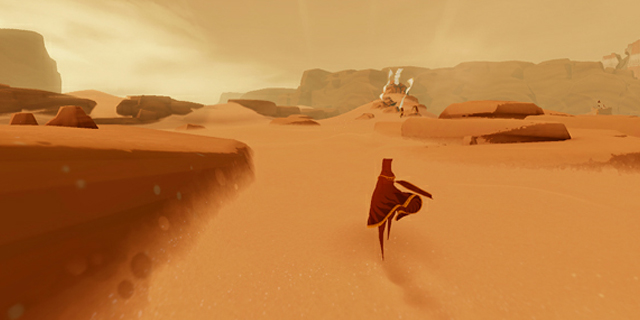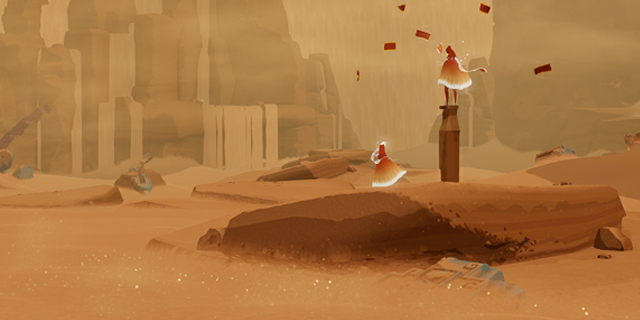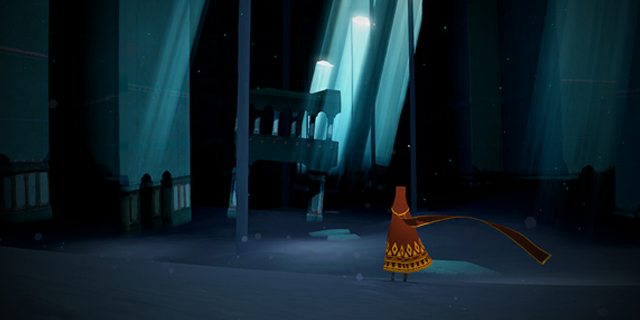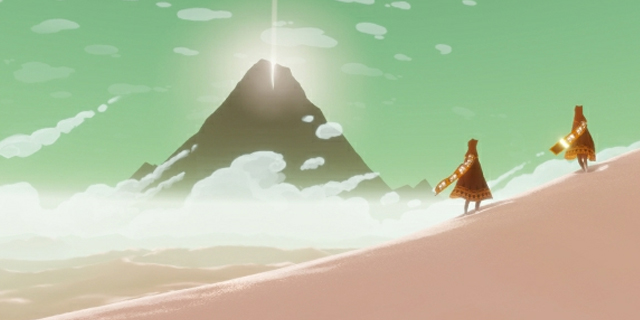
Editor’s note: This guest post by artist Riss Pittman contains Journey spoilers. If you haven’t played it yet, seriously go play it.
Developer thatgamecompany’s Journey focuses not only on intuitive exploration, but also the emotive experience that is a core element of the game. It was created first and foremost to dive into the possibilities of invoking an emotional response out of the player. It takes a very cinematic approach to the presentation, almost like an interactive animated film, that never stops letting the player have a hand in how they view the world. Through use of visuals, sound, music, and a minimal approach to text or dialogue, Journey immerses the player in a very unique emotional journey that isn’t often seen in games.
Before delving too far, it’s important to the address the idea of games as an art medium. Games aren’t particularly respected by society and are viewed either as a childish waste of time, or as politicians want the public to believe, a vehicle for teaching violence to children. Even notable critics like Roger Ebert have scoffed at the idea of games being capable of being art forms. This often comes from a major misunderstanding of what art is and isn’t, and what games can and can’t be.

Games are, as author Tom Bissell puts it, an “extra life” for players. It’s a way for players to get away from their daily lives; much like art can serve as a form of escapism for artists and viewers. This willingness for players to separate themselves from external pressures of life makes them especially receptive to emotional impact within the game – or art piece. Like any proper interactive piece of art, a game just needs to develop a core concept and find a way to express it in a way that is not only a strong experience for the player, but also functional as an interactive medium. This is just the same as how an artist has to consider not only the technique they use to create their work and how it will be shown to the public, as well as developing their strong core concept and meaning that the final work will express.
Games just haven’t really been given the chance to blossom in this regard. Much like comics were looked down upon in the time Roy Lichtenstein created his comic pop art, games aren’t really given the full breadth of respect they deserve. They need to continue to have thinkers like thatgamecompany founder Jenova Chen and Braid creator Jonathan Blow pushing the boundaries of what games can and can’t do, and opening the mind of the public up to being able to realize what games are fully capable of as a conceptual medium. Games have an edge over many other media in that they allow the player to directly interact with the work. It’s not only about the artist’s representation of their piece, but in a way it becomes the player’s work too because of how they add a little of themselves into the way they play the game.

An important wall to break through for the interpretation of games as art is to realize that like any medium, not all games are art. Just like not all cinema is an art film and advertisements aren’t necessarily artworks (unless later elevated to such a status by critics), not all games can be art. The thing that separates a game like Call of Duty – an enjoyable romp similar to the summer’s newest blockbuster action flick – from games like Journey and Flower is that it was not actually created to be a conceptual work. Similarly, any old commercial graphic work isn’t an art piece the same way that Warhol’s paintings, while taking a cue from ads, were a pivotal part of the art of his era. Both critics and the public need to get past the idea when discussing games as art is that it’s not about “all games are art, period,” so much as games are capable of being artworks if the developers set out with that intent.
Through both its technical approach and emotive approach, Journey provides an unrivaled experience to its players. Journey really makes good use of its medium to form a connection not only with the player to the game, but from the player to their anonymous companions. It was carefully constructed to be a seamless experience for the player, and achieve a perfect sense of flow to allow the player to become fully open and receptive to the imagery and experiences the game provides and aware of how it makes them feel. The game almost seems to have been created to discount the idea that many “games as art” naysayers have about how “games can’t make you feel.” The smorgasbord of emotions Journey elicits completely discounts this idea. The game even drove me to tears at one point, because of the bond I had developed for both my player character and his companion. I use the word ‘he’ in a completely interpretive way – the player character is represented as completely androgynous so as to let the player project themselves onto the character with ease. I see the character as a ‘he,’ but it is left completely up to the person playing to identify the traveler as they so choose.

One of the most important aspects of a video game is the narrative. Outside of specific genres (puzzle games, fighting games, racing games, etc), it’s hard to motivate a player through the game’s entirety without even some semblance of a story or general narrative. Journey approaches this with the most minimal approach to be effective, as it only gives the player a basic goal and vague visual story elements along the way. However, instead of giving the player a sense of frustration or boredom due to lack of elaboration, it elicits a sense of wonder as the player treks out into the great unknown. Upon finishing a short intro that presents the player with their goal – make it to this mountain in the far distance – the player is left standing in a desert free to progress the game as quickly or slowly as they wish. This openness for the player to customize his or her playing experience is integral to Journey, and really ties into the core idea that the game as a whole is an allegory for life and death.
The game boiled down to its very basics is the tale of a lone traveler (the player) who journeys through a vast openness to an ultimate goal (the mountain) meeting anonymous strangers along the way. It is up to the player to decide whether they want to cooperate with the strangers for a single task, ignore them completely, or even continue their journey together and in the process form an unspoken bond with them. The road to the final goal is filled with wonderment and fraught with danger, and nearing the end the weakened player must continue to push on with or without their companions. Finally upon reaching the mountaintop they collapse, only to be revived by a group of spiritual figures and summoned to a beautiful oasis in the sky.

Explaining this almost makes it painfully obvious the underlying meaning of the tale. It is clearly a birth-youth-adulthood-death-heaven tale, with commentary along the way about making crossroads with other people and the hardships faced in the journey through life. The game creators cleverly mask this under the vague idea of the traveler exploring the ruins of an ancient civilization while aided by a spiritual guide (who is hinted at being one of those ancient people) who shows the traveler imagery of the history of their people. The tale is incredibly loose and is never expressed through text or dialogue, so it allows the player to make their own assumptions on what the true meaning of the game is. Coupling this allegorical narrative with the breathtaking visuals, the cinematic score by composer Austin Wintory and the simple-but-effective gameplay, it provides a unique and heart-rending experience.
Now even an inspired meaning to the work is not enough, it is only an important aspect. The real underlying concept present here in Journey is “emotion.” David Freeman proposed the idea of “emotioneering,” or a way of letting the player experience “an interlocking sequence of emotional experiences.” He also emphasizes the need to make games and their characters “both conceptually interesting and emotionally deep.” This idea of emotioneering is very present in Journey and is the core purpose to everything presented within the game. The player is encouraged and provoked in a variety of ways to not only bond with the game, but become immersed enough to feel emotion at all times. To achieve this conceptual emotion, the game utilizes a sense of flow using all of the prior aspects described – narrative, visuals, music, and controls – to allow the player the utmost comfort and immersion. It is of the utmost importance for the player to sink into this sense of flow, much like they would sink into a comfortable, safe-feeling couch to play, so they are as receptive as possible to the feelings of emotion.

What is this “flow,” exactly? Chen wrote of this integral game experience in 2007. As he explains, the ‘flow’ experience in games “represents the feeling of complete and energized focus in an activity, with a high level of enjoyment and fulfillment.” It allows the player to form a link with the game and experience it at its fullest. Instead of feeling frustration at poor game design, poor controls or other badly executed aspects of the game, the player instead becomes as though they are almost a part of the world depicted in the game itself.
Utilizing this sense of flow to fully immerse the players into the game, Journey allows them to feel a full range of emotions at what is presented and what they interact with. The player may start simply being impressed at the beauty of the landscape they are allowed to run about, but that quickly morphs into excitement at the world around them, joy, and curiosity. While the player cannot die or game over (as this would harm the feeling of flow) they still feel dread, fear, and a sense of foreboding at segments of the game. As mentioned earlier, there was in fact a part of the game that I myself got so attached to what was happening I was driven to tears. Near the endpoint, the traveler is weak and no longer has the zest present earlier in the game (a metaphor for old age) but as the player I was still determined the make it up the mountain. My anonymous companion was present, and often times my heart raced when I felt their safety was threatened by strange creatures patrolling the area from the sky. But we finally managed to make it up the mountain, to the peak. Too weak to continue we forced ourselves onward anyway, our scarves (which represent the life-force of the traveler) being torn away by the wind. I felt and overwhelming feeling of sadness as we pushed forward, worrying we’d never make it until I finally started openly crying as both my companion and I collapsed on the snowy mountaintop.

In this moment, I realized the full extent of Chen and Journey’s success at what they set out to do. The game, conceptually, was not only meant to provide an enjoyable playing experience but to cause me, the player, to feel emotions I did not feel often (or even ever) while playing a game. I felt it wanted me to see the value in a game as an art form, eliciting feelings I often got from standing in front of a beautiful, awe-inspiring work in a museum. I felt awe, excitement, joy, sadness, and even feelings that I cannot quite describe. After our characters collapsed, they were soon revived by our spiritual guides and spirited away to the shining peak amongst the swell of beautiful music. I felt a feeling of happiness and victory I can barely describe – like the amazement of seeing a Da Vinci in person, it’s a kind of feeling one has to experience first-hand to fully understand.



















